From the June 2021 issue of Apollo. Preview and subscribe here.
It is hardly coincidental that some of the most insightful tributes to cities have been written, sung or painted by artists raised far beyond their walls. Perhaps the unique characteristics of a city are more readily grasped by those who see them with fresh eyes. From Mann’s Venice to Isherwood’s Berlin, experiences gained from mobility and migration seem to lend new prisms through which an urban fabric can be seen and better understood. Bellotto’s Dresden is no exception.
‘Bernardo Bellotto, called Canaletto, made [this painting] in the year 1747 in Dresden.’ These are the words engraved in capital letters on a large stone conspicuously placed in the foreground of the artist’s first view of the city, where he was appointed court painter to Augustus III, King of Poland and Elector of Saxony. Bellotto invites his viewer to retrace what must have been his own initial steps along the right bank of the River Elbe. The prominence of water against the backdrop of a church resembling Santa Maria della Salute is fitting for a young artist who grew up in Venice and learned his craft in a studio specialising in the representation of that city. That studio, of course, belonged to his famous uncle, from whom he borrowed his sobriquet as well as his technique and repertoire.
Venice and Dresden had far more in common than a major waterway running through their centres. The cultural exchanges between the two cities were extensive and cultivated by royal patronage. In fact, Bellotto painted his first view of Dresden from the house of Franz Josef von Hoffmann, who had accompanied the heir to the Saxon throne, Friedrich Christian, during his Grand Tour to Venice. There Hoffmann met not only his future wife, Felicita Sartori, the favourite pupil of Rosalba Carriera, but also Consul Smith, the great benefactor of Canaletto. Part of the same entourage was the physician Filippo di Violanti, who stands in the foreground of Bellotto’s veduta, his face in profile reminiscent of Pier Leone Ghezzi’s caricature of him. To his left, seen from behind, is the alto castrato Nicolò Pozzi. Noted for his heavenly voice as much as for his pronounced corpulence, Pozzi premiered in several operas by Johann Adolph Hasse, another honorary citizen of both Dresden and Venice. In short, Bellotto’s roots were never far away in his adopted home.
While the wooden boat entering the picture from the left seems to foreshadow imminent departure into the distance, the stone on which Bellotto chose to carve his name and date suggests a desire to stay. The artist himself sits cross-legged on another stone in the central foreground, elegantly dressed and equipped with the tools of his profession. He is eagerly conversing with Christian Wilhelm Ernst Dietrich and Johann Alexander Thiele, fellow view painters at the Saxon court. The latter, already an elderly man, gesticulates towards a wall under construction, as if heralding a new age. Correspondingly, Pietro Guarienti, himself a painter and connoisseur of some renown, in charge of the royal picture gallery in Dresden since 1746, would extol Bellotto’s promise a few years later: ‘Being still young and indefatigable in his studies and attention to detail, it is to be hoped that his name will become famous and celebrated.’
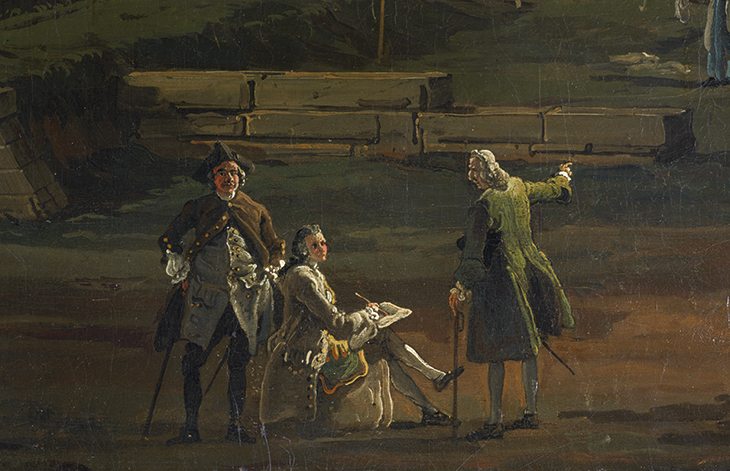
Dresden from the Right Bank of the Elbe Above the Augustus Bridge (detail; 1747), Bernardo Bellotto. Photo: Elke Estel/Hans-Peter Klut; © Gemäldegalerie Alte Meister, Staatliche Kunstsammlungen Dresden
Not even Guarienti could have anticipated that Bellotto’s paintings would come to be synonymous with the golden age of Dresden, the ultimate manifestation of a city at the height of its powers. Neither could he have envisaged their value. One of two paintings of Guarienti’s native Verona that Bellotto executed was offered at auction in London this July. (Although the patron who commissioned the two views of Verona has yet to be firmly identified, the painting and its pendant, now at Powis Castle, are recorded in England in the 1770s.) The hammer price of £10m was not far off the value of 350kg of gold which Augustus III, assisted by Guarienti, paid in exchange for the 100 masterpieces from the collection of Francesco III d’Este that today form the heart of the Gemäldegalerie.
While the scores of visitors who – outside of a global pandemic – flock to the museum every year to admire Bellotto’s paintings as windows on to the past, his contemporaries would have seen them as representations of both present and future. Almost all of the buildings that can be identified in Bellotto’s first view of Dresden were either recently completed or under construction. Just as in Bellotto’s circle, the efforts of Saxons and Italians jostle for attention. Prominent among them are Brühl’s palace, library and picture gallery, the latter acting like a base to the Frauenkirche towering above it. Further to the right, at the head of Pöppelmann’s Augustus Bridge rises Chiaveri’s Hofkirche, still lacking its imposing tower. A walk across the bridge leads into the Neustadt, largely rebuilt following a devastating fire in 1685. It is there, right by the bridge, that the court jester Joseph Fröhlich had his house, which is visible in the background. Despite his last name literally meaning ‘cheerful’, this colourfully garbed, rotund figure stands somewhat apart from the group with Pozzi and Violanti, with only a dog for company.
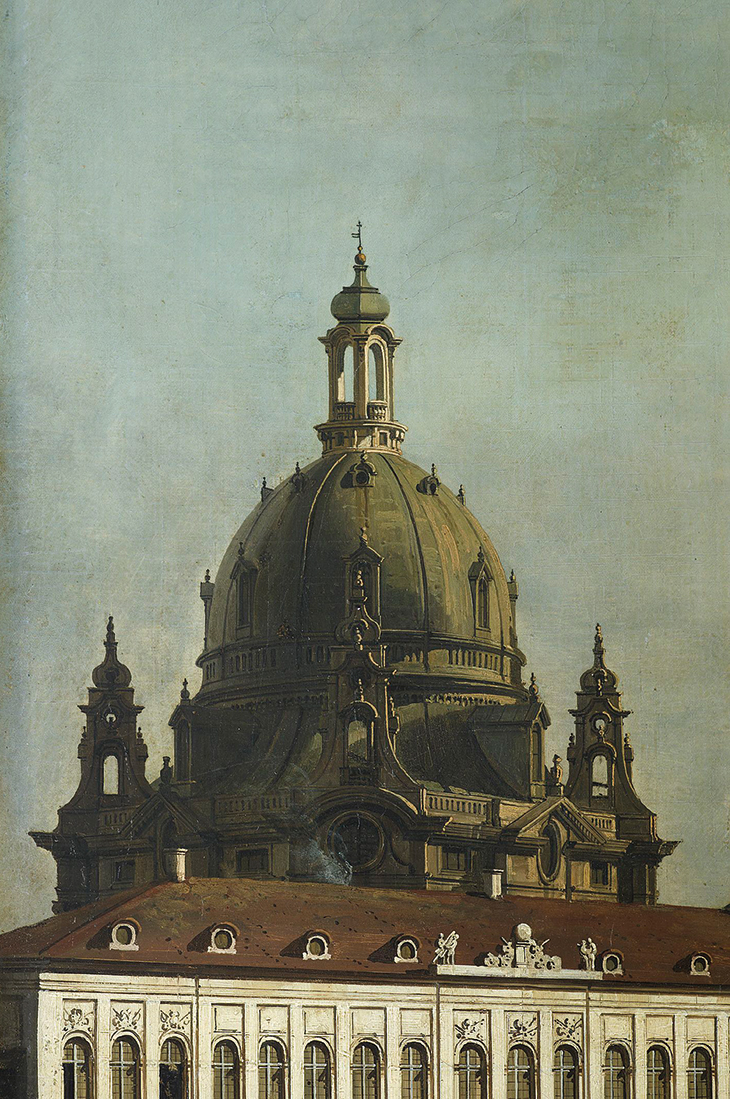
Dresden from the Right Bank of the Elbe Above the Augustus Bridge (detail; 1747), Bernardo Bellotto. Photo: Elke Estel/Hans-Peter Klut; © Gemäldegalerie Alte Meister, Staatliche Kunstsammlungen Dresden
More than 400 years after Ambrogio Lorenzetti executed his frescoes in the Palazzo Pubblico, Siena, Bellotto seems intent to show the effects of good government, flattering his intended viewers. Hindsight only adds to the appeal of these paintings. Even within Bellotto’s lifetime his idyllic vision was in peril, as the city fell victim to Prussian invasion during the Seven Years’ War. Yet the pictures’ historical value acquired even greater poignancy after the city’s near annihilation in the closing months of the Second World War. That Bellotto’s paintings survived both cataclysms – thanks to their being stored away safely in the fortress of Königstein, an important subject of Bellotto’s in its own right (and one to which the National Gallery in London is dedicating an exhibition opening in July) – is nothing short of miraculous. They can now be read as warnings against the effects of bad government.
Contrary to popular belief, the city that went up in flames in February 1945 had long ceased to be the Dresden Bellotto knew. Frederick II of Prussia’s bombardment of the city, especially of anything belonging to his arch-enemy Count Brühl, had played an important role. However, wilful demolition in later periods was far more consequential. Brühl’s gallery, one of the first buildings in the world purposely designed to house paintings, was removed in 1887. The Palais Brühl, the first documented home of Bellotto’s vedute, was torn down in the 1890s to create space for the Saxon House of Estates. So too was the Palais Fürstenberg, from 1768 seat of the Academy of Fine Arts, where Bellotto taught. The Augustus Bridge was completely rebuilt between 1905 and 1910 to widen the arches for increasingly larger ships. Fortunately, the Hofkirche was spared from a similar fate and later narrowly escaped complete destruction by Allied bombing.
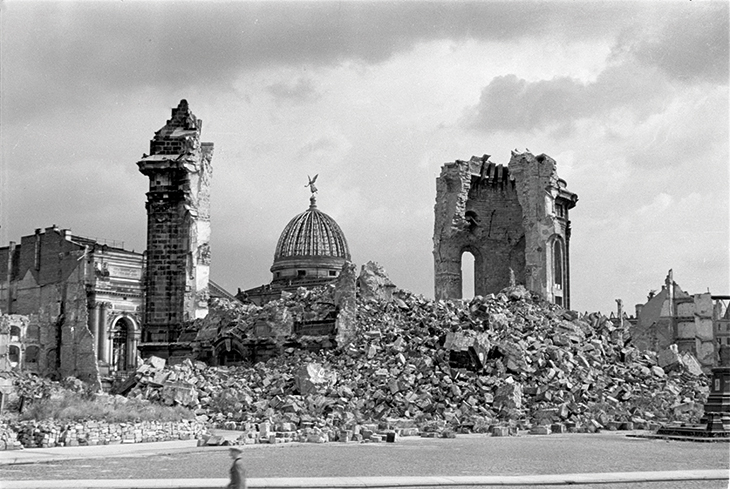
The ruins of the Frauenkirche, Dresden, with the dome of the Lipsius-Bau in the background, photographed by Richard Peter in 1945
The Frauenkirche was less fortunate. A famous photograph shows the building shortly after the air raids had reduced it to a ruin. Its remaining walls frame the dome of the Lipsius-Bau (which Dresdeners wittily nickname the lemon squeezer), making the golden angel on top of it seem to rise above the vast pile of rubble. A man walking past in the foreground – recalling the staffage populating Bellotto’s scenes – gives a sense of the scale of the disaster. Understandably, then, the remains were declared a war memorial in 1966. However, in the aftermath of the fall of the Iron Curtain, a desire arose to recapture something of the lost city centre. In 1991, the decision was made to rebuild the Frauenkirche according to George Bähr’s original plans; thanks to generous support from around the world the church was reconsecrated in 2005.
Along with the rising of the Frauenkirche, attention started to focus on the restoration of the quarter around it ‘to its historical appearance as a harmonious piece of town planning’. Disgruntled by ‘the large number of faceless, if functional, new buildings in the centre of Dresden, [the members of the Gesellschaft Historischer Neumarkt e.V.] consider it the last chance to give Dresden back its old identity’. While the Zwinger, Residenzschloss and Semperoper had already been reconstructed during the Communist era, many other buildings had been purposefully demolished or left to decay. As in Warsaw, where the artist would later become court painter, Bellotto’s paintings of Dresden have acquired added meaning, being treated as both sources and advocates for the city’s rebuilding, rather than as mere pieces of nostalgia. Whether the creation ex nihilo of concrete structures with counterfeited baroque facades contributes to generating an identity in the 21st century remains to be seen. It has certainly provided a bespoke setting for the Frauenkirche that has not only impressed visitors from around the world, but also inspired similar campaigns elsewhere, notably in Frankfurt and Potsdam.
However natural it may be to regard Bellotto’s paintings as objective sources, there is a great risk involved in treating them as photographs in an age before the advent of photography. While individual buildings are often rendered with startling accuracy, recent research has shown how Bellotto adjusted the scenery to suit his requirements. The way in which he anticipated the completion of the tower of the Hofkirche is well known, but this is far from the only instance of his manipulation of his environs. Much, perhaps too much, has been made of his use of the camera obscura, which has reinforced the fallacy that his paintings faithfully record what he would have seen in front of him. By contrast, scholars have convincingly demonstrated the artist’s indebtedness to Dutch genre paintings, which had already left a profound impression on his uncle in terms of style and subject matter. The more evidence in support of this frequently ignored thesis turns up, the more it becomes clear that Bellotto’s paintings should not be used as a conduit to understanding how Dresden once was, but to how the artist wanted us to see it.
As with Bellotto more than 270 years ago, my own ship recently docked in the city in the hope to stay and settle. The circumstances of my arrival at the beginning of November 2020, just as all cultural institutions closed again, could hardly have been less permitting, with Bellotto’s paintings off-limits to the public. If I have found a single silver lining, it has been the many extended walks through the city and its surroundings. While the urban fabric has changed significantly since Bellotto’s day, there are surprising relics dotted throughout the city.
The house known as the Anchor on Königstrasse 10, located in the heart of the beautifully preserved baroque quarter of the Neustadt, is one of them. Had Bellotto walked by it, he might have encountered Johann Joachim Winckelmann, who resided there in 1754–55, receiving drawing lessons from his landlord and gathering his ‘Reflections on the Imitations of Greek Works in Painting and Sculpture’. A routine doctor’s appointment led me to a still more impressive monument in another part of the city. As I walked across the premises of a hospital, surrounded by bleak residential buildings, nothing prepared me for the sight of one of the most important baroque fountains to have survived. Dedicated to Neptune, it formerly graced the main axis of the garden palace that Johann Christoph Knöffel designed for Count Brühl. The fountain, which prominently features in Giovanni Battista Tiepolo’s The Empire of Flora, now in San Francisco, is the crowning achievement of Bellotto’s friend Lorenzo Mattielli, who also carved the statues adorning the Hofkirche.
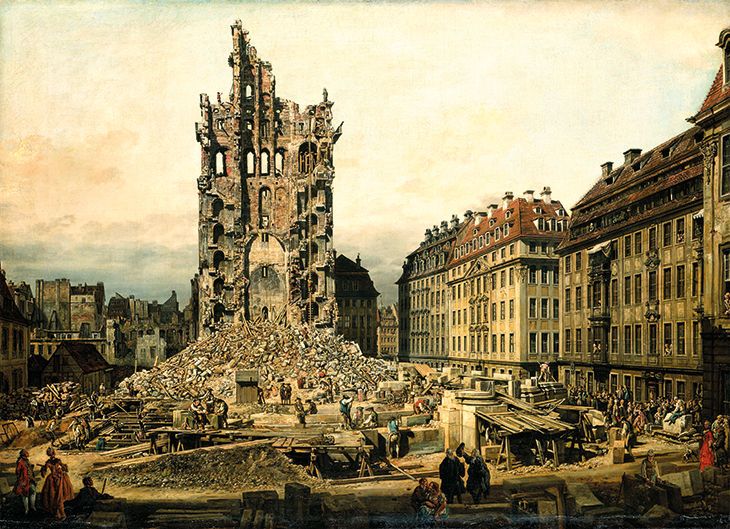
The Ruins of the Kreuzkirche in Dresden (1765), Bernardo Bellotto. Photo: Elke Estel/Hans-Peter Klut; © Gemäldegalerie Alte Meister, Staatliche Kunstsammlungen Dresden
Survivals such as these lead me back to the stone on which Bellotto affixed his signature in his first view of the city, itself seemingly a remnant of a bygone structure and era. It evokes fragments of ancient temples commonly found throughout Rome. We know that a few years prior to his arrival in Dresden, Bellotto attentively studied the ruins of the Eternal City. This experience informed many of his subsequent works, providing an additional frame of reference for one of his last paintings of Dresden, the celebrated view of the ruins of the Kreuzkirche, which had been devastated by Prussian cannons in 1760. Perhaps this painting says more about the identity of Dresden than any of his other views of the city. Scars are an inevitable part of that identity. That would be a sombre point to end on were it not for the majestic dignity of this ruin, the courageous people ascending it and the many well-preserved buildings by which it is surrounded. As tempting as a recreation of Bellotto’s Dresden might seem, there is plenty of interest in the Dresden in which Richard Wagner composed his Lohengrin, Erich Kästner ‘was a little boy’ and Gerhard Richter would take up his brush. Renewal – as we can well imagine Bellotto discussing with Dietrich and Thiele in that first view of Dresden – is another form of preservation.
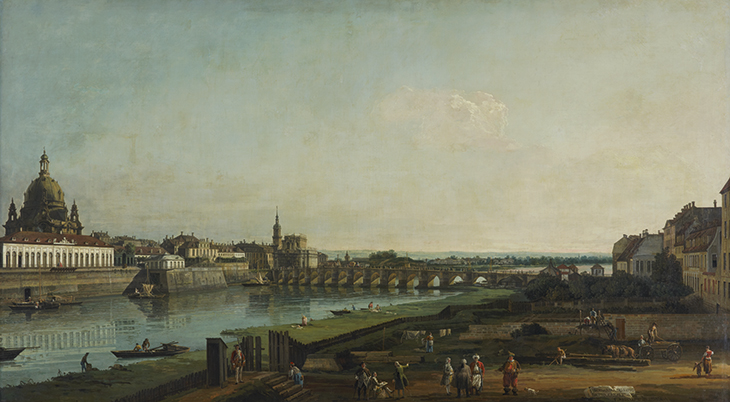
Dresden from the Right Bank of the Elbe Above the Augustus Bridge (1747), Bernardo Bellotto. Photo: Elke Estel/Hans-Peter Klut; © Gemäldegalerie Alte Meister, Staatliche Kunstsammlungen Dresden
‘Bellotto: The Königstein Views Reunited’ is at the National Gallery, London, from 22 July–31 October.
From the June 2021 issue of Apollo. Preview and subscribe here.
Unlimited access from just $16 every 3 months
Subscribe to get unlimited and exclusive access to the top art stories, interviews and exhibition reviews.

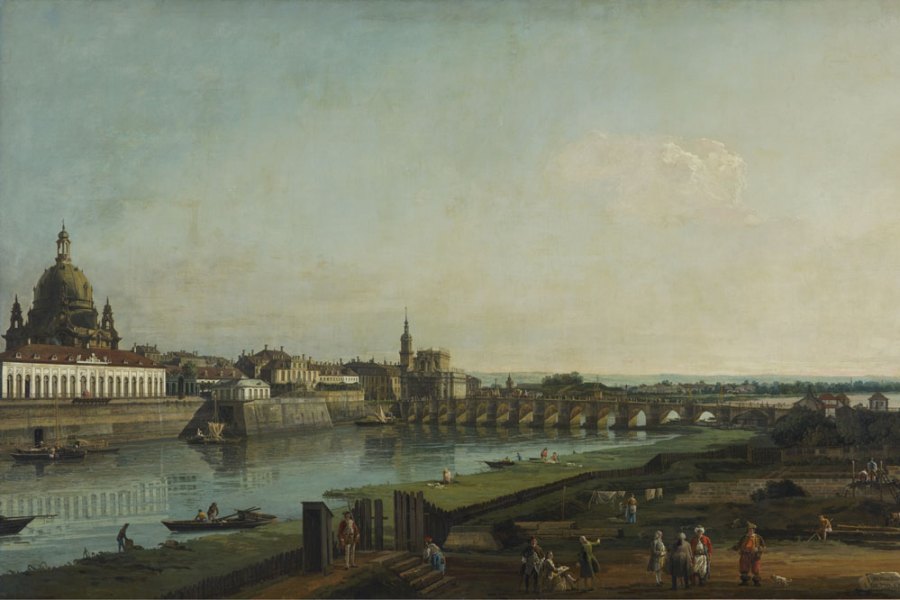
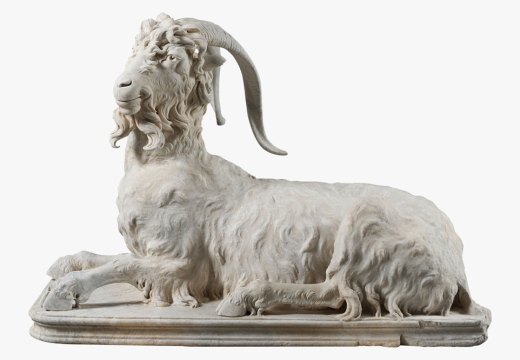
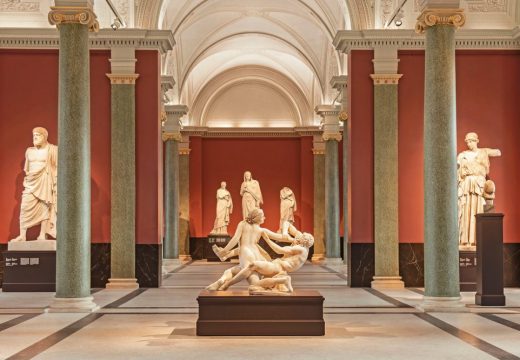
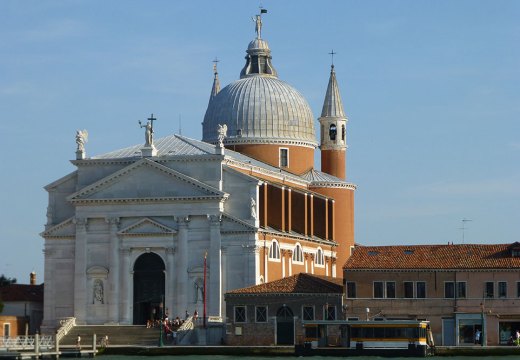









![Masterpiece [Re]discovery 2022. Photo: Ben Fisher Photography, courtesy of Masterpiece London](http://www.apollo-magazine.com/wp-content/uploads/2022/07/MPL2022_4263.jpg)
It’s time for the government of London to return to its rightful home